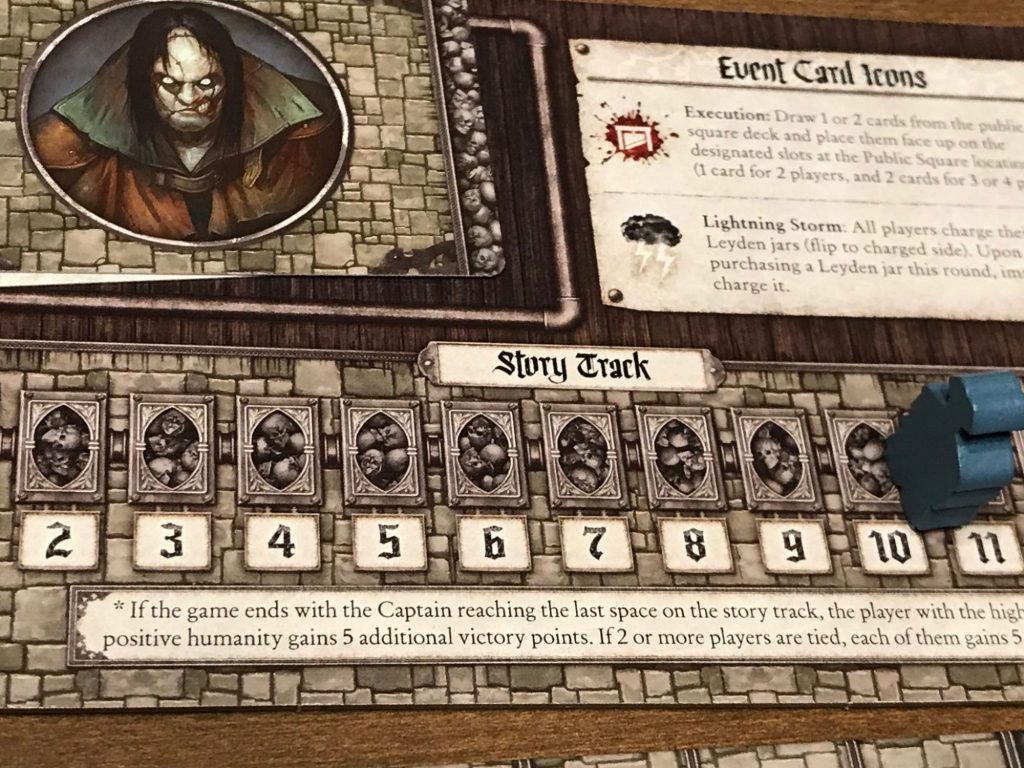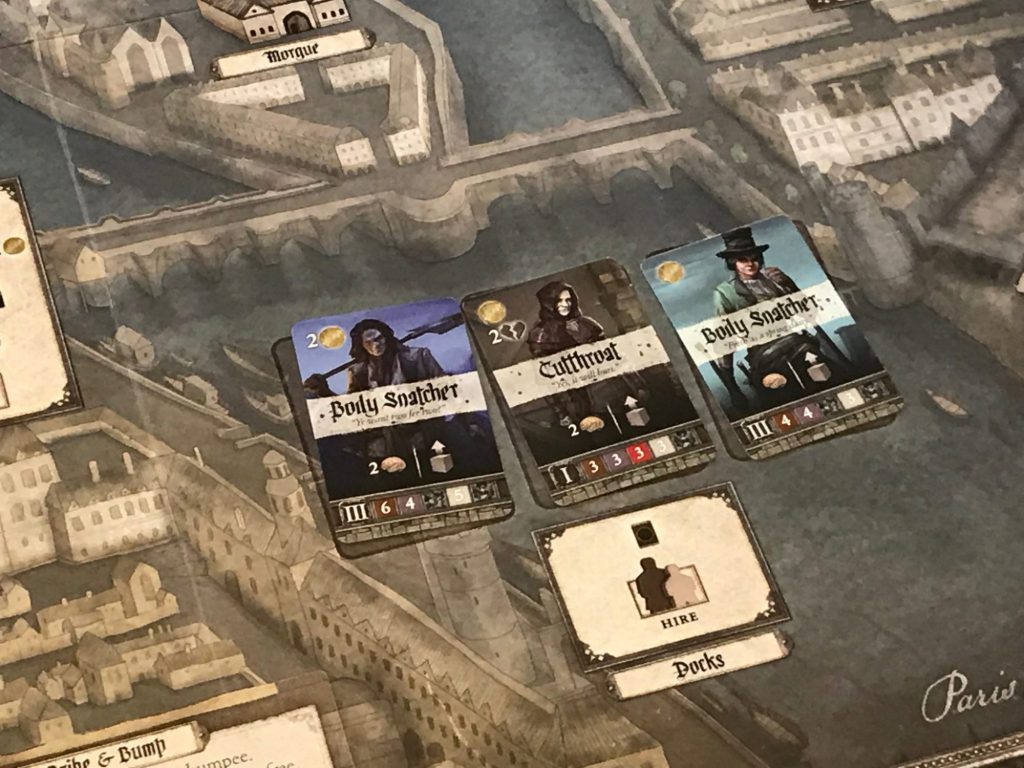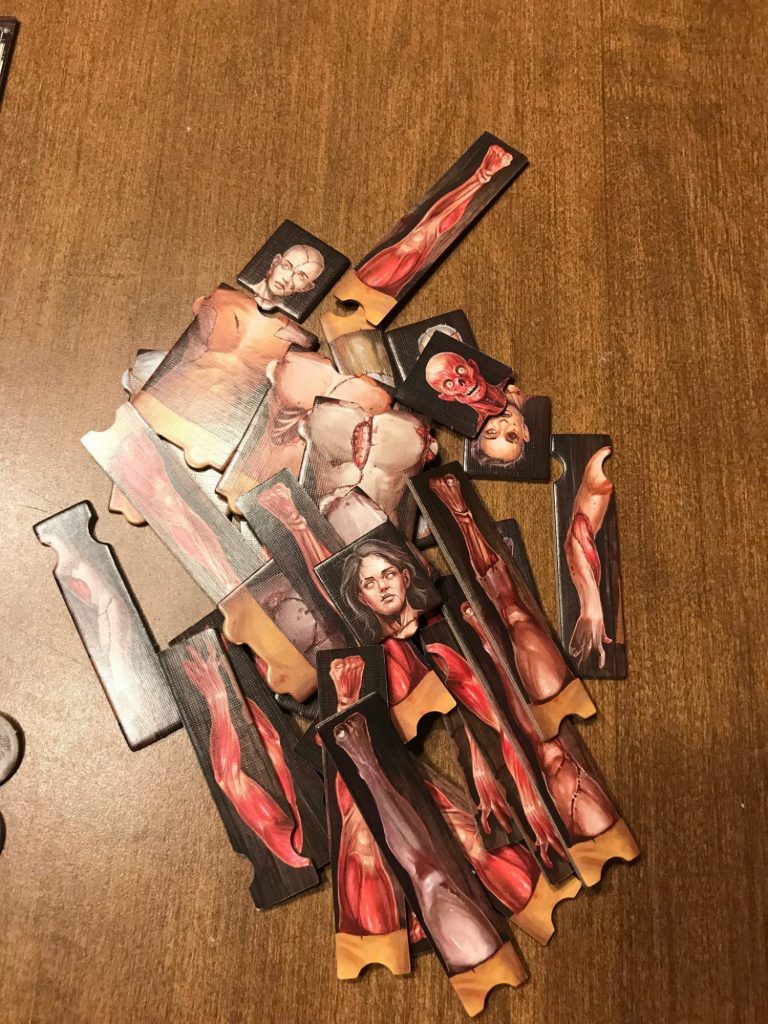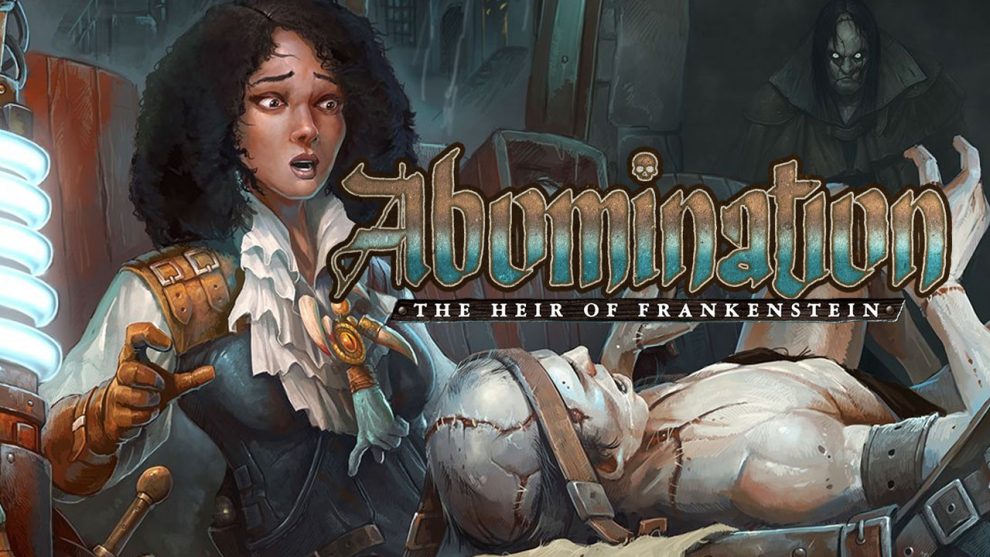“With how many things are we on the brink of becoming acquainted, if cowardice or carelessness did not restrain our inquiries.”
― Mary Shelley, Frankenstein
Monster Mashup
In the summer of 1997 I was assigned ten books to read as part of my Advanced English class my sophomore year of High School. One was Frankenstein by Mary Shelley. My prior experience of “gothic” was defined by the black-trenchcoat wearing students who roamed the school hallways drawing The Crow symbols on their notebooks. But Frankenstein showed me a different side of Gothic artistry. That it wasn’t about mood or fashion; rather, it was about intellectual exploration into the human psyche. And this literary masterpiece showed me the macabre could be refined.
It is in this space that Abomination: The Heir of Frankenstein prowls. Plaid Hat Games’ newest strategy title designed by Dan Blanchett for 2-4 players is an amalgamation of immersive theme and worker placement mechanisms. On the surface it’s a brooding game filled with skinless limbs, severed heads, and the dark Parisian underworld. But buried underneath you’ll discover a refined game that meticulously crafts a tight Euro experience.
Creating a Monster
At the end of the classic tale, the monster that Victor Frankenstein creates vanishes. Captain Robert Walton sees the monster floating away into “darkness and distance” in the Arctic Circle. Twenty years have passed from that moment to the opening of Abomination: The Heir of Frankenstein. The monster, known as the Creature in this game, has made his way to Paris and has conscripted a new group of scientists to create a suitable companion, and in turn unlock the secret to immortality. However, Captain Walton has caught wind of the foul creature and vows to return to destroy what he once let escape.

Like many worker placement games, the object of Abomination: The Heir of Frankenstein is to gain the most Victory Points by the end of the game. Points are obtained primarily through creating body parts from various resources like Organs, Bones, Muscles, and Blood which are represented by plastic cubes of various colors. Players can subsequently “shock” these body parts to life to score even more points at the end of the game. Points are also awarded (or lost!) for how players managed statistics like Humanity, Reputation, and Expertise.
At the start of the game each player is given a unique character with asymmetric special abilities. There are four phases that players resolve during each round of Abomination: the Event, City, Lab, and Reset phases which are described below.
Event Phase
Although this is a relatively quick phase to resolve, it is one of my favorite parts of the game. Abomination contains double-sided Encounter cards and Event cards which are shuffled together to form an Event Deck. The first player takes the top card off the deck and reads it to all players (there is an included Event cover card which sits atop this deck to prevent players from seeing what’s coming each round).

Event cards generally introduce a new rule into the game that lasts for the current round, along with some flavor text that explains the incident. For example, there may be a destructive lightning storm that rolls through Paris, which closes down outdoor locations like the Cemetery and Docks, but it also charges every players’ Leyden jars (a component needed to “shock” created limbs to life). Encounter cards cause an incident to occur to one player and often present a choice. The player may receive a visit from the Creature who demands to see your progress, or they may encounter Captain Walton or a denizen of the underworld of Paris.
These encounters usually require players to flip to the back of the rulebook to the story appendix which is filled with passages players read based off the cards that are drawn and choices they select. Think of this like the Ryan Laukat games Above & Below or Near & Far… but this is more like Dead & Disturbing. As a result of these Encounters a player may receive rewards in extra materials, a boost in stats, or even bonus actions. But they may receive penalties in the same vein. After the card is resolved players move to the next phase.
City Phase
The City board is a map representing Paris in 1819 and filled with locations that will aid you in your various misdeeds. All players begin the game with one Scientist and two Assistant workers. Starting with the first player and proceeding clockwise, players may place one of their Scientist workers or Assistant workers onto a location and resolve the effect of that location. Scientists are more powerful; they can be deployed on any space and often gain stronger effects than Assistants. There are also some spaces that only Scientists can occupy. Players may gain an extra Assistant over the course of the game, and later upgrade Assistants to Scientists (more on this later). In general players are trying to harvest materials (cubes) to create body parts that form their new monster. This is done by gaining corpses which are found at various locations around Paris (more on this later).

Corpses are represented by cards that display two things: the cubes you collect of each material – organs, blood, bones, and muscles – and how “decomposed” these materials are (stage I, II, III, or IV with stage I being the “freshest”). They may also have a cost in either money or Humanity, which is a stat you must manage over the course of the game. You can also acquire animal parts which serve as “wild” materials, but they will slightly decrease the value of your monster.
Aside from these locations there are a few others your flunkies may visit. The Academy gives Research cards which can either give you an in-game boost to your stats or income, or they can be used to help improve your odds at bringing a body part to life. At the Church you can gain cards that help regain some Humanity and other circumstantial benefits. The Docks location allows you to hire one of a number of different scoundrels that will aid your schemes. And finally you can visit the Market to buy materials needed to complete your research, such as Leyden jars or ice blocks which help preserve your materials.

Once all players have deployed their workers into these locations (or passed) then gameplay proceeds to the third phase.
Lab Phase
All players activate this phase simultaneously. This is where you assume the role of mad scientist and get to play with the materials you’ve collected. Every player has their own Lab board which has spaces to hold your stage I, II, III, and IV materials as well as Leyden jars and ice blocks. Players can turn in cubes to start making body parts and score points based off the stage of materials they use. Every body part (Head, Torso, Arms, Legs) requires different combinations of muscle, organ, blood, and bone cubes. When a body part is started, players take the cardboard version of that part and lay it onto their lab board with the “skinless” side showing. Later, players can finish their body parts by turning in the required cubes to flip the part over to the “skin” side and score even more points.

Once a player has at least one finished body part they can start “shocking” their monster to life. This involves rolling dice to determine success. To “shock” body parts players need charged Leyden jars. For every charged jar they spend (indicated by flipping the jar to the uncharged side) players get 2 dice to roll, up to a total of 6 dice. The dice have four different outcomes. Some faces show “damage” which must be distributed on the body parts. If a part has two damage it “degrades” to a lower form. Another face is blank, another causes loss of Humanity, and another causes the body part to become “awake.” Players can spend unused Research cards to re-roll some or all of the dice, depending on the card text.
Reset Phase
The first thing that happens in the Reset phase is fitting of the theme: any unused materials decompose (with the exception of bones which never decompose). If you have unspent cubes in Stage I they slide into Stage II. If they are in Stage IV the materials will completely decompose and the cubes are removed from your board. However if a player has a block of ice in their inventory they may skip this decomposition (though ice melts, so it won’t keep things preserved forever).
If no player has fully brought their monster to life, then the board is cleaned up in the reset phase. This simply involves pulling the Scientists and Assistants back to the players, and replacing most of the face-up cards left around the board. Captain Walton advances one space forward on his track.
The game ends if one player fully creates a monster and brings all body parts to life. But Captain Walton is hunting the Creature in Paris, and if he advances beyond the 12th space the game ends immediately; for the Captain has found the Creature and thwarted your efforts. This effectively serves as a game timer, putting constant pressure on the players. Players will still score points for their accomplishments in this situation, with minor scoring adjustments.
Lightning Strikes
Like a bolt that filled all my Leyden jars, lightning struck brilliantly with Plaid Hat Games’ newest strategy game. This is one of those rare Euro games whose theme oozes with the intensity of a decaying limb. As a teenager who grew up on classics like The Crow, Interview with the Vampire, A Nightmare Before Christmas, The Addams Family, and Pee Wee’s Big Adventure the macabre is right up my Dark Alley (ok, that didn’t sound right) so I was immediately drawn to the theme. The artwork is dark and gloomy, and puts the Frankenstein story on full display with corpse cards that feature severed heads, slit throats, and other decayed deformities. Might want to put this one out of the younger kids’ reach.

This is also a game where the gameplay and design not only support the theme but enhance it. Yes this is a game with workers and cubes, but you really begin to emulate the mad scientist role as you plot how to gain corpses, allocate the materials you collect, and assemble your monster. The manner by which you collect corpses is a perfect example of this interplay between theme and mechanism:
The Public Square has the corpses that provide some of the most abundant materials, but public executions only occur when the event deck indicates and you must pay to retrieve one of these corpses. The hospital provides the next-best corpses, but the only way to get them is to have a high Reputation (you at least need to appear to be a doctor!) or you can hire someone at the Docks location to steal them for you for a steeper cost. The Morgue comes next, and you can pick between the top two bodies that you pull from the shelves (stack).
The Cemetery has the worst corpses, but the only cost is your Humanity. To get bodies at the Cemetery you literally “dig down” through a stack of face-down cards and then proceed to select the ones you want. Corpses are buried underground at the Cemetery… you never know what you’re going to get! The best corpse is at the Dark Alley where you perform an aforementioned Murder and gain the most abundant resources. However this has the steepest cost of Humanity you’ll find in the game, creating a high-risk, high-reward location.
The Lab board also adds to the feeling that you’re at work doing the Creature’s bidding. At the bottom of the Lab board are three dials which track your Humanity, Reputation, and Expertise. Your Humanity is often a cost for obtaining corpses, but if it sinks too low it will cause you to lose points at the end of the game. High Humanity can not only award you points but boost your Reputation. The Reputation dial will give you greater access at the Hospital location. High Reputation also causes your Assistants to upgrade to Scientists which greatly increases your flexibility in the City.
Finally, you need increasingly higher Expertise to create various body parts. A head is much more complex than an arm, so it requires higher Expertise. And once you’ve started a body part, finishing it takes even greater Expertise. As your Expertise grows you also will gain upgraded dice to roll when shocking your monster. These dials not only enhance the gameplay but they visually make it look like you’re tweaking a diabolical device to raise the dead.

The decisions you make in this game feel weightier than a bloated torso. You often will not only have to balance when to place your Scientist versus your Assistants, but where to place them so that you are not blocked out on future placements. There is a limited amount of “bumping” each round, where one player may place their worker where another was placed at a cost. But you will more often than not feel the tension of needing to choose between more than one high-value location while being unsure you’ll get to visit them all.
Finally it must be mentioned that Abomination offers a high degree of replayability. When a game employs a narrative mechanism there is always concern that you’ll not need to return once you’ve heard all the stories. However this game includes an abundance of Encounter and Event cards that are double-sided and offer multiple choices, and only 12 are used each game (and you may not get to them all if the Captain is rushed or a player completes their monster). Needless to say, you may be playing this game until your dying breath before seeing every narrative option. These narrative experiences and asymmetric characters add layers of replayability to this well-constructed Euro.
Dark Corners
A few words of caution for you aspiring mad scientists. First, it goes without saying that the theme of this game is darker than Parisian catacombs. It’s not so over-the-top that it’s distracting or grotesquely offensive but “Mature gothic horror” would certainly be a reasonable description. So let’s just say that this one may have a challenge hitting the table depending on your crowd. My first play of this game was with my wife who is too afraid to watch Stranger Things. She rolled her eyes through the entire rules explanation. But by turn three she was standing up, hunched over the table, brooding over her gameplay choices. “Hah! You’re into this! I knew you would be!” I jeered, cackling as thunder cracked overhead… ahem.

Component-wise everything is as refined as Mary Shelley would desire. Plaid Hat Games makes gorgeous games and from top-to-bottom this one is no exception. But one minor complaint was that the copy I received did not have enough cubes. Even with three players we were harvesting so many corpses that the cubes vanished. Each Stage of your player board can hold 15 cubes for a total of 45 possible cubes in the materials area of each player’s board.
Author’s note: I have contacted Plaid Hat Games on this issue and they have taken note. To be clear, substitutions can be used in the event that materials cubes run out; they are an unlimited resource.
One other caveat when teaching new players: be careful with your money. Money is mostly used to buy things at the Market and pay someone at the Docks to do your bidding. But you can also pay to bump an opponent’s worker out of a spot so that you may use it. The game can be very tight early on when you only have one Scientist, because many spots in the City locations are only for Scientists. If you run out of money and are unable to bump players you may be locked out of any beneficial placement. After one play you’ll have a “heads up” (get it?) to avoid this trap.

Finally players should be aware that this game is long; longer than the box currently indicates at 60-120 minutes. My first two-player game took 120 minutes. A three player game took around 3 hours. So you will want to allocate plenty of time to play this one. But trust me, it’s worth the time and once you’re invested it’ll pass faster than the City Guard.
Authors note: I was also informed by Plaid Hat Games that the currently listed timeframe on the box will be adjusted for future printings.
To Die For
Abomination: The Heir of Frankenstein is a tremendous win for Plaid Hat Games in this reviewer’s eyes. They’ve really stitched their expertise in theme and world-building together with die-hard Euro gameplay; and it works brilliantly. There are a number of mechanisms I love in this game including asymmetric workers, asymmetric character powers, and some of the most thematic resource gathering I’ve beheld in this type of game. And all of the pieces of the game fit together well enough to make even the Creature proud.
I’ve often seen concern that well-produced games can use artistry as a skin over lackluster gameplay. I assure you that isn’t the case here; the game is a brilliantly designed beast. As the Creature lurks in shadows and Captain Walton advances on his hunt, you feel tension between your placement options as you outwit your opponents to construct your monster. I also loved that you can score points by going heavy on building your monster, or on managing the dials, but you’ll need to do both to do well.
The theme serves the gameplay and enhances it. Even if the artwork and subject matter causes hesitation, I hope many players become acquainted through unrestrained inquiry with the machinations of this brilliant game. If you enjoy, or can get past, a theme that’s as dark as the Battle of Winterfell, Abomination: The Heir of Frankenstein is a worthy companion for any worker placement collection and I hope to see more Euro-style games like this from Plaid Hat Games!
Abomination: The Heir of Frankenstein was featured in our Most Anticipated Games of Gen Con 2019.












Add Comment